
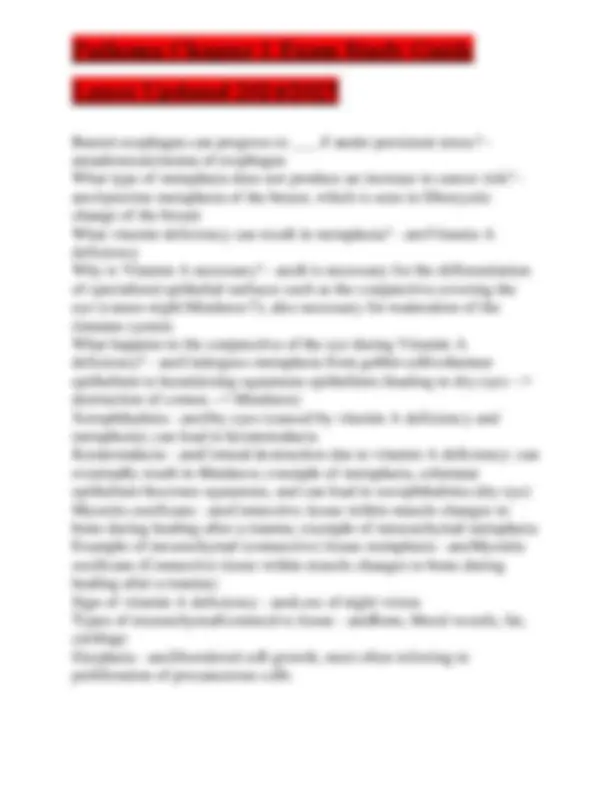
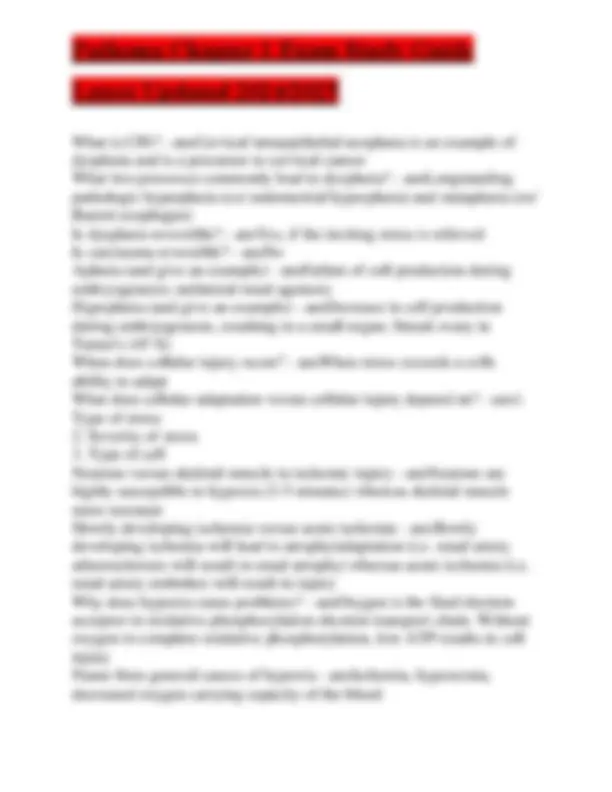
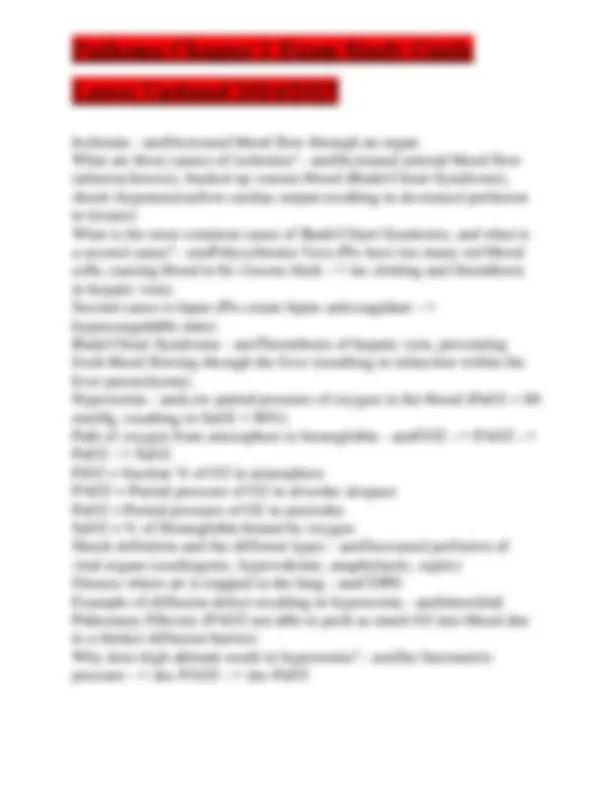


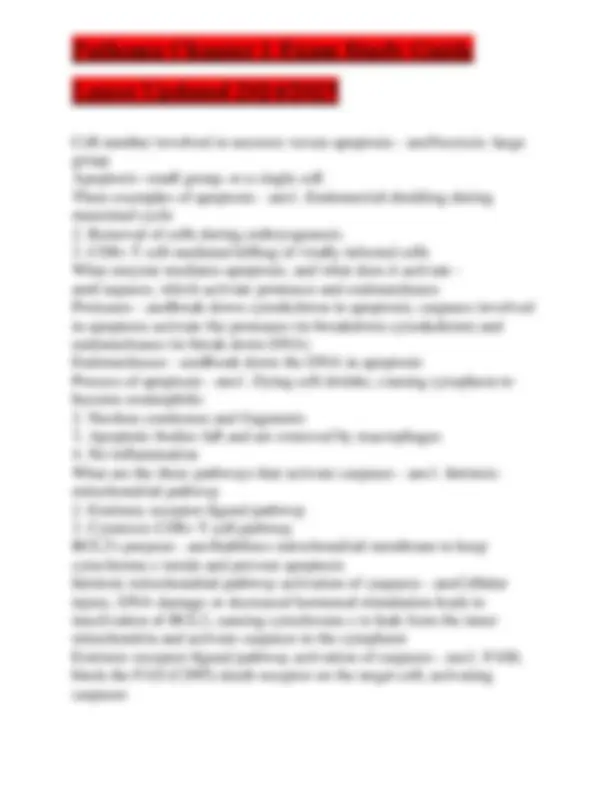
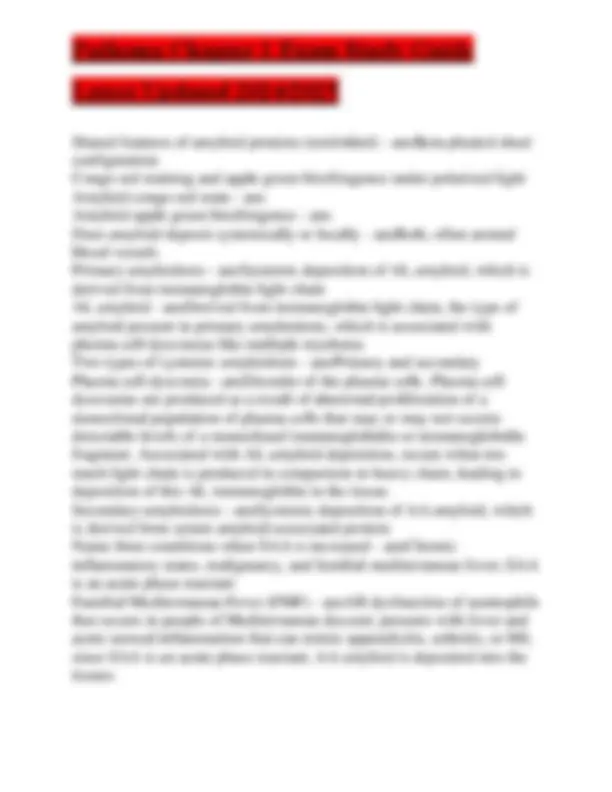




Study with the several resources on Docsity

Earn points by helping other students or get them with a premium plan


Prepare for your exams
Study with the several resources on Docsity

Earn points to download
Earn points by helping other students or get them with a premium plan
Community
Ask the community for help and clear up your study doubts
Discover the best universities in your country according to Docsity users
Free resources
Download our free guides on studying techniques, anxiety management strategies, and thesis advice from Docsity tutors
Various topics related to cellular injury and adaptation, including hyperplasia, hypertrophy, stem cells, metaplasia, dysplasia, cellular injury, cell death (apoptosis and necrosis), free radicals, and amyloidosis. It provides detailed explanations and examples of these concepts, making it a valuable resource for students studying pathology, cell biology, or related fields. The document delves into the mechanisms underlying these cellular processes, the factors that can lead to cellular injury, and the consequences of such injury. By studying this document, students can gain a comprehensive understanding of the complex interplay between cellular structure, function, and response to various stimuli and stressors.
Typology: Exams
1 / 15

This page cannot be seen from the preview
Don't miss anything!










What leads to an increase in organ size? - ansIncrease in stress What are the two processes via which an organ can increase in size? - ansHyperplasia (increase in number of cells) and hypertrophy (increase in size of cells) What are three processes/events that occur in hypertrophy? - ansGene activation, protein synthesis, production of organelles Where do the new cells in hyperplasia come from? - ansStem cells What tissues cannot undergo hyperplasia, only hypertrophy? - ansPermanent tissue, i.e. skeletal muscle, cardiac muscle, nerve tissue What is the only type of muscle that can undergo hyperplasia? - ansSmooth muscle (i.e. uterus) How do cardiac myocytes respond to hypertension? - ansHypertrophy, not hyperplasia
Picture shows left ventricular hypertrophy Hyperplasia that occurs due to underlying pathologic process - ansPathologic hyperplasia Pathologic hyperplasia pathway - ansHyperplasia --> dysplasia --> cancer What is one exception to the rule that pathologic hyperplasia can lead to cancer? - ansBenign prostatic hyperplasia does not increase the risk for cancer What leads to atrophy? - ansDecrease in stress --> decrease in organ size What are the two processes that cause atrophy? - ansA decrease in the size of cells (via ubiquitin-proteosome degradation of the cytoskeleton and autophagy of cellular components) and a decrease in the number of cells (via apoptosis) Where are the three places stem cells are found? - ansBone marrow, skin, base of intestinal crypts
What is Ubiquitin? - ansProtein put on intermediate filaments of the cytoskeleton to mark them for degradation in ubiquitin-proteosome degradiation (decrease cell size) What does a Proteasome do? - ansDestroys ubiquitin-tagged proteins, often intermediate filaments What does ubiquitin tag in atrophy? (to reduce cell size) - ansIntermediate filaments What destroys ubiquitin tagged proteins? - ansProteosomes Autophagy - ansCell consumes its own components in vacuoles, which fuse with lysozomes, whose hydrolytic enzymes breakdown the cellular components in the vacuoles What are the two processes in atrophy that can decrease cell size - ansUbiquitin-proteosome degradation (to decrease cytoskeleton) and autophagy (to decrease organelles) What promotes metaplasia? - ansA change in stress on a cell --> change in cell type (metaplasia) What is Epithelium? - ansCells that line body surfaces What type of cells are most commonly involved in metaplasia? - ansChange of one type of surface epithelium to another (i.e. squamous, columnar, urethelial/transitional) Barrett's Esophagus - ansNon-keratinized squamous epithelium of the esophagus becomes non-ciliated, mucin producing columnar cells (normal cell in stomach) This is done to better handle the stress of acid reflux in the esophagus Is metaplasia reversible? - ansYes, in theory, with the removal of the driving stressor Ex/ treatment of GERD may reverse Barrett esophagus How does metaplasia occur? - ansVia reprogramming of stem cells, which then produces a new cell type Metaplasia to cancer pathway - ansMetaplasia --> dysplasia --> cancer
What is CIN? - ansCervical intraepithelial neoplasia is an example of dysplasia and is a precursor to cervical cancer What two processes commonly lead to dysplasia? - ansLongstanding pathologic hyperplasia (ex/ endometrial hyperplasia) and metaplasia (ex/ Barrett esophagus) Is dysplasia reversible? - ansYes, if the inciting stress is relieved Is carcinoma reversible? - ansNo Aplasia (and give an example) - ansFailure of cell production during embryogenesis; unilateral renal agenesis Hypoplasia (and give an example) - ansDecrease in cell production during embryogenesis, resulting in a small organ; Streak ovary in Turner's (45 X) When does cellular injury occur? - ansWhen stress exceeds a cells ability to adapt What does cellular adaptation versus cellular injury depend on? - ans1. Type of stress
Ischemia - ansDecreased blood flow through an organ What are three causes of ischemia? - ansDecreased arterial blood flow (atherosclerosis), backed up venous blood (Budd-Chiari Syndrome), shock (hypotension/low cardiac output resulting in decreased perfusion to tissues) What is the most common cause of Budd Chiari Syndrome, and what is a second cause? - ansPolycythemia Vera (Pts have too many red blood cells, causing blood to be viscous thick --> inc clotting and thrombosis in hepatic vein). Second cause is lupus (Pts create lupus anticoagulant --> hypercoagulable state) Budd Chiari Syndrome - ansThrombosis of hepatic vein, preventing fresh blood flowing through the liver (resulting in infarction within the liver parenchyma); Hypoxemia - ansLow partial pressure of oxygen in the blood (PaO2 < 60 mmHg, resulting in SaO2 < 90%) Path of oxygen from atmosphere to hemoglobin - ansFiO2 --> PAO2 --> PaO2 --> SaO FiO2 = fraction % of O2 in atmosphere PAO2 = Partial pressure of O2 in alveolar airspace PaO2 = Partial pressure of O2 in arterioles SaO2 = % of Hemoglobin bound by oxygen Shock definition and the different types - ansDecreased perfusion of vital organs (cardiogenic, hypovolemic, anaphylactic, septic) Disease where air is trapped in the lung - ansCOPD Example of diffusion defect resulting in hypoxemia - ansInterstitial Pulmonary Fibrosis (PAO2 not able to push as much O2 into blood due to a thicker diffusion barrier) Why does high altitude result in hypoxemia? - ansDec barometric pressure --> dec PAO2 --> dec PaO
Hallmark of reversible cell injury - ansCellular swelling (including loss of microvilli, membrane blebbing, and decreased protein synthesis due to ribosomes popping off ER) Goal for Ca in cytosol, and why? - ansGoal is to keep Ca low in the cytosol, because Ca can activate enzymes. When the Ca pump is dysfunctioning due to a lack of ATP, Ca concentration increases in the cytosol of the cell Hallmark of irreversible cellular injury - ansMembrane damage (phospholipid, mitochondrial, and lysosome membrane) Two results of phospholipid membrane damage due to low ATP - ans1. Enzymes leak into the blood (i.e. what you are measuring when you get troponins and LFTs)
What type of necrosis follows ischemic infarction in all organs except the brain? - ansCoagulative necrosis (liquefactive in the brain) What is the shape and color of infarcted tissue due to ischemia/coagulative necrosis? - ansWedge shaped with pale color Two causes of acute inflammation - ansInfection Necrosis When can a red infarction (as opposed to pale) arise? - ansBlood reenters a loosely organized tissue (lungs, testicle, bowel) What is the pathogenesis of ischemia in a testicular infarction? - ansThe testicle twists on the spermatic cord, causing the vein to be compressed but the artery is not compressed, so blood gets backed up and fresh blood can't flow into the tissue Necrotic tissue becomes liquefied due to enzymatic lysis of cells and proteins, causing liquefaction - ansLiquefactive necrosis Three processes that present with liquefactive necrosis - ansBrain infarction Abscess Pancreatitis (parenchyma, NOT surrounding fat) What causes liquefactive necrosis in the brain? - ansMicroglial cells (equivalents of monocytes) release proteolytic enzymes, which liquefy the brain Abscess - ansWalled off area of dead tissue (neutrophils inside walled off area) Why does an abscess present with liquefactive necrosis? - ansProteolytic enzymes of neutrophils liquefy the tissue Why does pancreatitis present with liquefactive necrosis? - ansProteolytic enzymes from the pancreas liquefy the parenchyma Gangrenous necrosis - ansCoagulative necrosis that resembles mummified tissue What artery is commonly occluded in diabetics, leading to gangrenous necrosis of the foot? - ansPopliteal artery
Cell number involved in necrosis versus apoptosis - ansNecrosis: large group Apoptosis: small group, or a single cell Three examples of apoptosis - ans1. Endometrial shedding during menstrual cycle
Shared features of amyloid proteins (misfolded) - ansBeta-pleated sheet configuration Congo red staining and apple green birefringence under polarized light Amyloid congo red stain - ans Amyloid apple green birefringence - ans Does amyloid deposit systemically or locally - ansBoth, often around blood vessels Primary amyloidosis - ansSystemic deposition of AL amyloid, which is derived from immunoglobin light chain AL amyloid - ansDerived from immunoglobin light chain, the type of amyloid present in primary amyloidosis, which is associated with plasma cell dyscrasias like multiple myeloma Two types of systemic amyloidosis - ansPrimary and secondary Plasma cell dyscrasia - ansDisorder of the plasma cells. Plasma cell dyscrasias are produced as a result of abnormal proliferation of a monoclonal population of plasma cells that may or may not secrete detectable levels of a monoclonal immunoglobulin or immunoglobulin fragment. Associated with AL amyloid deposition, occurs when too much light chain is produced in comparison to heavy chain, leading to deposition of this AL immunoglobin in the tissue. Secondary amyloidosis - ansSystemic deposition of AA amyloid, which is derived from serum amyloid-associated protein Name three conditions when SAA is increased - ansChronic inflammatory states, malignancy, and familial mediterranean fever; SAA is an acute phase reactant Familial Mediterranean Fever (FMF) - ansAR dysfunction of neutrophils that occurs in people of Mediterranean descent; presents with fever and acute serosal inflammation that can mimic appendicitis, arthritis, or MI; since SAA is an acute phase reactant, AA amyloid is deposited into the tissues
What organ is most commonly involved in systemic amyloidosis? - ansKidney Classic findings of systemic amyloidosis - ansNephrotic syndrome, restrictive cardiomyopathy/arrhythmia, tongue enlargement, malabsorption (due to thickened bowel), hepatosplenomegaly How do you diagnosis amyloidosis? - ansTissue biopsy (often from abdominal fat pad and rectum) How do you treat amyloidosis? - ansDamaged organs must be transplanted Restrictive cardiomyopathy - ansHeart is unable to fill well because the wall is not flexible What is the second most common protein in the blood? - ansTransthyretin Localized amyloidosis - ansAmyloid deposition in a single organ What deposits in senile cardiac amyloidosis? - ansNon-mutated serum transthyretin How does a person with senile cardiac amyloidosis present? - ansUsually asymptomatic, present in 25% of those over 80 Familial amyloid cardiomyopathy - ansMutated serum transthyretin deposits in the heard, leading to resrictive cardiomyopathy What is the difference between senile and familial amyloidosis in the heart? - ansSenile: non-mutated transthyretin; often asymptomatic Familial: mutated transthyretin deposits; leads to restrictive cardiomyopathy (symptomatic) Localized amyloidosis in non-insulin-dependent diabetes mellitus (type II) - ansAmylin, derived from insulin, deposits in the islets of the pancreas Amyloid in Alzheimers - ansDeposition of ABeta-Amyloid extracellularly in the brain as plaques Where is the gene for A-Beta Amyloid that deposits in the brain in ALZ, and what implications does this have? - ansGene is located on